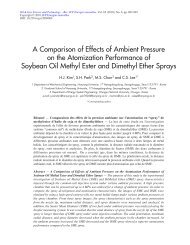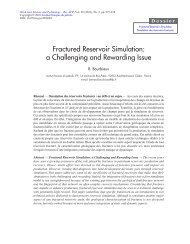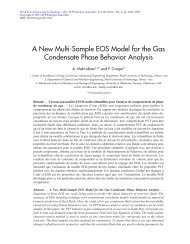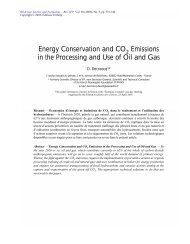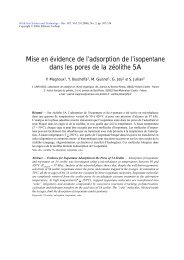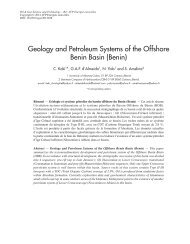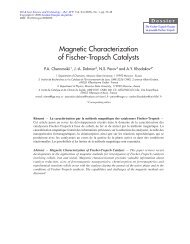the eddith thermolysis process - Oil & Gas Science and Technology ...
the eddith thermolysis process - Oil & Gas Science and Technology ...
the eddith thermolysis process - Oil & Gas Science and Technology ...
You also want an ePaper? Increase the reach of your titles
YUMPU automatically turns print PDFs into web optimized ePapers that Google loves.
THE EDDITh THERMOLYSIS<br />
PROCESS<br />
A GROUND-BREAKING SOLUTION FOR CLEAN<br />
TREATMENT OF WASTES<br />
G. H. MARTIN, É. MARTY <strong>and</strong> P. FLAMENT<br />
Institut français du pétrole 1<br />
R. WILLEMIN<br />
THIDE Environnement 2<br />
LE PROCƒDƒ DE THERMOLYSE EDDITh<br />
UNE SOLUTION INNOVANTE POUR UN TRAITEMENT PROPRE<br />
DES DƒCHETS<br />
Les rŽglementations en vigueur relatives aux rejets<br />
atmosphŽriques des incinŽrateurs et la volontŽ des pouvoirs<br />
publics de supprimer les dŽcharges d s le dŽbut de la prochaine<br />
dŽcennie conduisent ˆ une forte dem<strong>and</strong>e en installations neuves.<br />
Les rŽgions qui pratiquent encore la mise en dŽcharge devront<br />
sÕŽquiper dÕusines de traitement ad hoc et les incinŽrateurs<br />
construits il y a plus dÕune vingtaine dÕannŽes devront souvent<br />
cŽder la place ˆ des unitŽs plus performantes rŽpondant aux<br />
exigences du lŽgislateur. Au total, plus de 200 installations<br />
nouvelles devraient voir le jour dÕici dix ans rien quÕen France. Les<br />
perspectives de marchŽ sont encore plus gr<strong>and</strong>es en Europe,<br />
puisque le probl me de lÕŽlimination des dŽchets se pose<br />
sensiblement dans les m mes termes dans les pays voisins.<br />
THE EDDITh THERMOLYSIS PROCESS<br />
A GROUND-BREAKING SOLUTION FORCLEAN TREATMENT OF WASTES<br />
The current regulations concerning atmospheric pollutant<br />
discharge by incinerators, <strong>and</strong> <strong>the</strong> determination of public<br />
authorities to do away with waste dumps as of <strong>the</strong> beginning of <strong>the</strong><br />
next decade are leading to a heavy dem<strong>and</strong> for new installations.<br />
Areas which still use <strong>the</strong> dump method will have to equip<br />
<strong>the</strong>mselves with purpose-built plants, <strong>and</strong> incinerators built more<br />
than twenty years ago will in many cases have to make way for<br />
more efficient units which meet <strong>the</strong> requirements of <strong>the</strong> legislators.<br />
In all, more than 200 new installations should be erected within <strong>the</strong><br />
next ten years in France alone. The market prospects are even<br />
greater in Europe as a whole, since <strong>the</strong> problem of waste disposal<br />
exists under very much <strong>the</strong> same conditions in neighbouring<br />
countries.<br />
EL PROCEDIMIENTO DE TERMîLISIS EDDITh<br />
SOLUCIîN INNOVADORA PARA UN TRATAMIENTO LIMPIO DE LOS<br />
RESIDUOS<br />
(1) 1 et 4, avenue de Bois-PrŽau,<br />
92852 Rueil-Malmaison Cedex - France<br />
(2) 1, rue F. Raynaud,<br />
91100 Corbeil-Essonnes - France<br />
Las normativas vigentes, relativas a las evacuaciones<br />
atmosfŽricas de los incineradores y la voluntad de los poderes<br />
pœblicos consistentes en suprimir los vertederos desde principios<br />
de la pr—xima dŽcada conducen a una intensa dem<strong>and</strong>a en cuanto<br />
a nuevas instalaciones. Las regiones en que aœn se sigue<br />
procediendo a las descargas en vertederos, deber‡n equiparse<br />
con plantas adecuadas para el tratamiento de residuos y desechos<br />
y los incineradores construidos hace ya m‡s de unos veinte a–os<br />
REVUE DE L’INSTITUT FRANÇAIS DU PÉTROLE<br />
VOL. 53, N° 2, MARS-AVRIL 1998<br />
217
THE EDDITh THERMOLYSIS PROCESS<br />
deber‡n ser sustituidos por unidades de caracter’sticas superiores<br />
y que respondan a los requerimientos de la normativa. En total,<br />
m‡s de 200 nuevas instalaciones se deber‡n implantar de aqu’ a<br />
diez a–os, nada menos que en Francia. Las perspectivas de<br />
mercado son aœn mayores en Europa, ya que el problema de la<br />
eliminaci—n de los residuos se plantea de forma acuciante en los<br />
mismos tŽrminos al tratarse de los pa’ses vecinos.<br />
INTRODUCTION<br />
Although incineration is today <strong>the</strong> only means of<br />
satisfactorily meeting <strong>the</strong> needs of large conurbations, <strong>the</strong><br />
situation is much more flexible where refuse treatment in<br />
rural or moderately urbanized areas is concerned, or in<br />
<strong>the</strong> case of ordinary industrial waste disposal. In <strong>the</strong>se<br />
areas, <strong>the</strong> social <strong>and</strong> economic context is different from<br />
that in <strong>the</strong> big cities, as are <strong>the</strong> possibilities of energy<br />
recovery. This is <strong>the</strong> analysis which led to <strong>the</strong> EDDITh<br />
<strong>process</strong> for <strong>the</strong>rmolysis of refuse, developed jointly by<br />
THIDE Environnement company <strong>and</strong> IFP, with <strong>the</strong><br />
financial assistance of ADEME <strong>and</strong> of ANVAR, <strong>and</strong> <strong>the</strong><br />
technical assistance of CEA.<br />
1 BRIEF REVIEW OF TERMINOLOGY<br />
RELATING TO THERMOLYSIS<br />
Thermolysis 1 is an operation which consists in<br />
heating a hydrocarbon-containing feedstock in <strong>the</strong> total<br />
absence of oxygen, with <strong>the</strong> objective of obtaining<br />
coke, oil <strong>and</strong> dry gases. By appropriate regulation of <strong>the</strong><br />
operating conditions, it is possible to maximize <strong>the</strong><br />
production of one or o<strong>the</strong>r of <strong>the</strong> phases, or to modify<br />
<strong>the</strong> quality of <strong>the</strong> products obtained. <strong>Gas</strong>ification<br />
clearly differs from <strong>the</strong>rmolysis, since it uses a certain<br />
amount of air (sub-stoichiometric) to ensure <strong>the</strong><br />
complete conversion of <strong>the</strong> hydrocarbon-containing<br />
feed into combustible gases. As to incineration, this is<br />
carried out with considerable excess air.<br />
Thermolysis is thus a <strong>process</strong> based on a very simple<br />
principle <strong>and</strong> it has been used on a large scale by<br />
mankind since time immemorial, first on biomass, <strong>the</strong>n<br />
on fossil fuels like coal <strong>and</strong> oil, <strong>and</strong>, soon, on refuse<br />
which now represents a far-from-negligible source of<br />
hydrocarbon-containing material [1]. Obviously, <strong>the</strong><br />
constantly increasing dem<strong>and</strong> for product quality <strong>and</strong><br />
energy efficiency implies that <strong>the</strong>rmolysis no longer<br />
means simply heating in a retort, which is <strong>the</strong> way it<br />
was practised in very ancient times. Processes such as<br />
<strong>the</strong> EDDITh <strong>process</strong> are very technical, <strong>and</strong> physical<br />
<strong>and</strong> chemical treatment of <strong>the</strong> feeds <strong>and</strong> products is<br />
associated with <strong>the</strong> actual <strong>the</strong>rmal treatment.<br />
2 OBJECTIVES<br />
In developing <strong>the</strong> EDDITh <strong>process</strong>, THIDE<br />
Environnement company <strong>and</strong> IFP aimed at finding <strong>the</strong><br />
(1) The term pyrolisis may also be used since it is identical from <strong>the</strong> chemical<br />
point of view.<br />
REVUE DE L’INSTITUT FRANÇAIS DU PÉTROLE<br />
VOL. 53, N° 2, MARS-AVRIL 1998<br />
218
THE EDDITh THERMOLYSIS PROCESS<br />
best solution to <strong>the</strong> economic <strong>and</strong> environmental<br />
constraints of local authorities <strong>and</strong> industrialists faced<br />
with <strong>the</strong> problem of waste disposal. Consequently, <strong>the</strong><br />
goals of <strong>the</strong> two partners were:<br />
– to reduce treatment costs, despite increasingly<br />
stringent specifications <strong>and</strong> regulations;<br />
– to avoid <strong>the</strong> production of flue gas treatment residue,<br />
which has become extremely expensive to stabilize<br />
<strong>and</strong> store;<br />
– to avoid <strong>the</strong> production of bottom ash, for which<br />
<strong>the</strong>re is less <strong>and</strong> less use;<br />
– to produce a multi-purpose tool capable of treating a<br />
very wide range of waste materials, both domestic<br />
<strong>and</strong> industrial;<br />
– to produce a tool which is sufficiently flexible to<br />
cope with severer legislation on pollutant emissions<br />
into <strong>the</strong> atmosphere;<br />
– to make <strong>the</strong> best possible use of <strong>the</strong> energy content of<br />
refuse, both in time <strong>and</strong> in space;<br />
– to develop a product which is easy to export because<br />
it can be adapted to waste upgrading schemes o<strong>the</strong>r<br />
than those used in France.<br />
3 PROCESS DESCRIPTION<br />
The outline of <strong>the</strong> <strong>process</strong> for <strong>the</strong> treatment of<br />
municipal wastes is shown in Figure 1. It comprises<br />
three main stages:<br />
– waste pretreatment,<br />
– <strong>the</strong>rmolysis stage,<br />
– treatment <strong>and</strong> storage of <strong>the</strong> fuel obtained.<br />
3.1 Waste pretreatment<br />
The waste is first of all roughly shredded to prevent<br />
objects larger than 15-20 cm from entering <strong>the</strong> <strong>the</strong>rmolyser.<br />
Then, ferrous metal is removed <strong>and</strong> <strong>the</strong> waste is<br />
dried. These steps are carried out with <strong>the</strong> facilities<br />
conventionally used in <strong>the</strong> waste treatment sector.<br />
3.2 Thermolysis<br />
The dried waste is fed into a rotary kiln indirectly<br />
heated by flue gases. Thermolysis is performed at a<br />
temperature between 400 <strong>and</strong> 600°C, in <strong>the</strong> complete<br />
absence of oxygen <strong>and</strong> at atmospheric pressure. The<br />
residence time of <strong>the</strong> waste in <strong>the</strong> kiln is 45 min. While<br />
in <strong>the</strong> kiln, <strong>the</strong> waste is <strong>the</strong>rmally cracked, resulting in<br />
<strong>the</strong> formation of solid residue <strong>and</strong> gas.<br />
Solid phase<br />
Solid phase<br />
purification<br />
Storage<br />
Industrial <strong>and</strong> domestic wastes<br />
Pretreatment<br />
Thermolysis<br />
Combustion applications<br />
Figure 1<br />
General outline of <strong>the</strong> <strong>process</strong>.<br />
The gaseous phase, which contains both dry gases<br />
<strong>and</strong> substances condensable at ambient temperature, is<br />
extracted from rotary kiln <strong>and</strong> burned without fur<strong>the</strong>r<br />
treatment in a combustion chamber adjacent to <strong>the</strong><br />
<strong>the</strong>rmolyser.<br />
The flue gases formed are used both to heat <strong>the</strong> kiln<br />
<strong>and</strong> to dry <strong>the</strong> damp refuse. The solid phase is<br />
withdrawn from <strong>the</strong> <strong>the</strong>rmolyser through an air lock.<br />
The combination of kiln + combustion chamber,<br />
which is fundamental to <strong>the</strong> <strong>process</strong>, was studied in<br />
detail by IFP <strong>and</strong> THIDE Environnement. Seals were<br />
<strong>the</strong> subject of particular attention in order to avoid<br />
ei<strong>the</strong>r release of combustible gas or penetration of air<br />
into <strong>the</strong> rotary kiln.<br />
It should be noted that, unlike o<strong>the</strong>r <strong>process</strong>es, <strong>the</strong><br />
fact of operating at around atmospheric pressure<br />
prevents from risks of explosion, while still allowing<br />
<strong>the</strong> required quality of product to be obtained <strong>and</strong> faster<br />
heating of <strong>the</strong> feed.<br />
3.3 Solid phase treatment<br />
<strong>Gas</strong> phase<br />
Combustion<br />
The solid phase, which is similar to coke, is first fed<br />
into a stirred container filled with water for removing<br />
<strong>the</strong> majority of <strong>the</strong> chlorine compounds, <strong>and</strong> for<br />
cooling.<br />
The cooling stage also separates some of <strong>the</strong> inert<br />
mineral material such as gravel, glass, non-ferrous<br />
metals, etc., which are recovered <strong>and</strong> washed for<br />
possible recycling. The coke, in suspension in <strong>the</strong><br />
water, is <strong>the</strong>n re-treated by crushing <strong>and</strong> washing, to<br />
REVUE DE L’INSTITUT FRANÇAIS DU PÉTROLE<br />
VOL. 53, N° 2, MARS-AVRIL 1998<br />
219
THE EDDITh THERMOLYSIS PROCESS<br />
reduce <strong>the</strong> chlorine content still fur<strong>the</strong>r. The final<br />
operation consists in filtering <strong>and</strong> drying, producing a<br />
fuel with around 20% moisture content, known<br />
commercially as CARBOR. The water used for <strong>the</strong><br />
treatment of <strong>the</strong> solid phase comes mostly from <strong>the</strong><br />
drying of <strong>the</strong> refuse, <strong>and</strong> can be recycled after<br />
appropriate treatment.<br />
This is <strong>the</strong> basic <strong>process</strong> scheme. It can be readily<br />
modified if required by <strong>the</strong> proposed use of <strong>the</strong><br />
CARBOR, or if importance is placed on recycling<br />
certain mineral fractions. For example, aluminum,<br />
which has not been oxidized during residence time in<br />
<strong>the</strong> <strong>the</strong>rmolyser, can be easily recovered by methods<br />
commonly used in some types of waste treatment.<br />
About ten patent applications for <strong>the</strong> EDDITh<br />
<strong>process</strong> <strong>and</strong> a number of its possible variations have<br />
been registered in France <strong>and</strong> abroad.<br />
<strong>the</strong>rmolyser. The model describes all <strong>the</strong> <strong>the</strong>rmal <strong>and</strong><br />
chemical <strong>process</strong>es that take place in <strong>the</strong> rotary kiln <strong>and</strong><br />
was validated by <strong>the</strong> results of <strong>the</strong> pilot unit (Fig. 2). It<br />
is now used for designing <strong>and</strong> optimizing future<br />
industrial units.<br />
IFP has also prepared a <strong>process</strong> book for a municipal<br />
waste treatment plant with a capacity of 40 000 t/year.<br />
The <strong>process</strong> book includes complete material <strong>and</strong><br />
energy balances. All <strong>the</strong> equipment has been selected<br />
<strong>and</strong> <strong>the</strong> unit control strategy has been decided. The<br />
<strong>process</strong> book includes <strong>the</strong> cost estimation of municipal<br />
waste treatment by <strong>the</strong> EDDITh <strong>process</strong>.<br />
THIDE Environnement started marketing <strong>the</strong> <strong>process</strong><br />
in 1995 <strong>and</strong> has been successful in having <strong>the</strong> new<br />
technique recognized by several regional authorities in<br />
Europe as <strong>the</strong> best way for <strong>process</strong>ing municipal solid<br />
wastes.<br />
4 PROCESS DEVELOPMENT<br />
After <strong>the</strong> promising tests carried out in <strong>the</strong><br />
laboratories of IFP <strong>and</strong> CEA, THIDE Environnement<br />
<strong>and</strong> IFP decided to build a pilot unit which could treat<br />
up to 500 kg/h of municipal wastes. The pilot unit was<br />
built at Vernouillet (Eure-et-Loir) in 1992 <strong>and</strong> operated<br />
for more than 16 months. In all, several hundred tons of<br />
municipal wastes from <strong>the</strong> town of Laval (Mayenne)<br />
were treated.<br />
While working on <strong>the</strong> pilot unit, <strong>the</strong> IFP also<br />
developed a computer model to simulate <strong>the</strong><br />
5 PROCESS PERFORMANCE<br />
An extensive parametric study was carried out on <strong>the</strong><br />
Vernouillet pilot unit. The study made it possible to<br />
determine, on an industrial scale, <strong>the</strong> optimum<br />
operating conditions for <strong>the</strong> <strong>process</strong> in terms of<br />
temperature, residence time, heat supply management,<br />
gas removal, waste flow rate, feed quality etc. A<br />
simplified material <strong>and</strong> energy balance is shown in<br />
Figure 3 <strong>and</strong> Table 1, for a feed with 15% moisture<br />
content. It can be seen that <strong>the</strong> <strong>process</strong> is <strong>the</strong>rmally selfsustaining.<br />
The energy released by <strong>the</strong> <strong>the</strong>rmolysis gas<br />
Figure 2<br />
Temperatures (K) in <strong>the</strong> rotary kiln at <strong>the</strong> surface<br />
of <strong>the</strong> solid phase <strong>and</strong> in <strong>the</strong> gas phase.<br />
REVUE DE L’INSTITUT FRANÇAIS DU PÉTROLE<br />
VOL. 53, N° 2, MARS-AVRIL 1998<br />
220
THE EDDITh THERMOLYSIS PROCESS<br />
Water 260 kg<br />
Tar 70 kg<br />
Dry gases 220 kg<br />
11.7 MJ/kg Combustion Evacuation<br />
Municipal Waste<br />
10-15% moisture<br />
1 ton<br />
Combustion<br />
air<br />
Thermolysis<br />
Solid phase<br />
450 kg<br />
12,5 MJ/kg<br />
Storage<br />
CARBOR<br />
320 kg<br />
18 MJ/kg<br />
Washing drying<br />
Inert matter<br />
130 kg<br />
Recycling<br />
Figure 3<br />
EDDITh <strong>process</strong>-material<br />
<strong>and</strong> energy balance.<br />
TABLE 1<br />
Material balance<br />
<strong>Gas</strong> 55%<br />
of which: water 26%<br />
tar 7%<br />
dry gases 22%<br />
Solid phase 45%<br />
of which: inert matter 13%<br />
CARBOR 32%<br />
is sufficient to supply <strong>the</strong> needs of <strong>the</strong> dryer <strong>and</strong> <strong>the</strong><br />
rotary kiln. For a ton of municipal wastes, around<br />
240 kg of CARBOR are recovered. The main<br />
characteristics of CARBOR are given in Table 2. This<br />
fuel has a calorific value of 18 MJ/kg (7 750 Btu/lb)<br />
<strong>and</strong> an ash content of less than 40%. It is homogeneous,<br />
with a grain size ranging from a few tens of microns to<br />
a few millimetres. It has a low sulphur content <strong>and</strong> <strong>the</strong><br />
chlorine content is never higher than 0.5%, a common<br />
figure for a number of coals available on <strong>the</strong> French <strong>and</strong><br />
European markets.<br />
The mineral matter extracted during <strong>the</strong> treatment of<br />
<strong>the</strong> solid phase does not contain any carbon-bearing<br />
substances. Nor, as analyses have shown, does it<br />
contain any pollutant substances, which means that it<br />
can be recycled, or failing that, it can be stored in<br />
ordinary l<strong>and</strong>fills.<br />
Table 3 shows <strong>the</strong> pollutant content of <strong>the</strong> flue gases<br />
resulting from <strong>the</strong> combustion of <strong>the</strong> <strong>the</strong>rmolysis gases.<br />
TABLE 2<br />
Characteristics of CARBOR<br />
Proximate<br />
analysis<br />
Ultimate<br />
analysis<br />
Ashes 38%<br />
Volatile matter 15%<br />
Calorific value<br />
18 MJ/kg<br />
Carbon 50.0%<br />
Hydrogen 1.6%<br />
Nitrogen 1.6%<br />
Sulphur 0.6%<br />
Chlorine 0.5%<br />
TABLE 3<br />
Pollutant content of flue gases produced<br />
by <strong>the</strong> combustion of <strong>the</strong>rmolysis gases<br />
Legislation of 25/01/1991*<br />
Values measured on pilot**<br />
NO 2 x<br />
: 470 mg/Nm 3<br />
N 2<br />
O: 1.6 mg/Nm 3<br />
CO: 100 mg/Nm 3 CO < 50 mg/Nm 3<br />
SO 2<br />
: 300 mg/Nm 3 SO 2<br />
< 200 mg/Nm 3<br />
HCl: 50 mg/Nm 3 HCl: 30 mg/Nm 3<br />
HF: 2 mg/Nm 3 HF < 1 mg/Nm 3<br />
Organic compounds<br />
Organic compounds<br />
20 mg/Nm 3 < 15 mg/Nm 3<br />
Pb + Cr + Cu + Mn:<br />
Pb + Cr + Cu + Mn:<br />
5 mg/Nm 3 1.6 mg/Nm 3<br />
Ni + As: 1 mg/Nm 3 Ni + As < 0.5 mg/Nm 3<br />
Hg + Cd: 0.2 mg/Nm 3 Hg + Cd: 0.2 mg/Nm 3<br />
* mg/Nm 3 of dry flue gases with 11% O 2<br />
.<br />
** 250 mg/Nm 3 expected with suitable low NO x<br />
burner.<br />
REVUE DE L’INSTITUT FRANÇAIS DU PÉTROLE<br />
VOL. 53, N° 2, MARS-AVRIL 1998<br />
221
THE EDDITh THERMOLYSIS PROCESS<br />
The observed levels of pollutant emissions are lower<br />
than <strong>the</strong> limits fixed by <strong>the</strong> regulations of January 25,<br />
1991, relating to waste treatment installations with a<br />
capacity of more than 3 t/h (<strong>the</strong> most restrictive<br />
regulations in France to date). The hydrochloric acid<br />
content is particularly low without <strong>the</strong> addition of any<br />
sorbent to <strong>the</strong> feed. This performance is explained by<br />
<strong>the</strong> self-neutralization of acid components by basic<br />
materials present in <strong>the</strong> waste. The desired effect was<br />
achieved by optimizing <strong>the</strong> <strong>the</strong>rmal profiles in <strong>the</strong><br />
rotary kiln <strong>and</strong> by using <strong>the</strong> appropriate reactor<br />
technology. Chlorine retention by <strong>the</strong> solid phase can<br />
reach levels of 97%, which is considerably higher than<br />
<strong>the</strong> results obtained by <strong>the</strong> conventional dry or semi-dry<br />
flue gas treatment units which still equip many plants<br />
today. By increasing <strong>the</strong> basicity of <strong>the</strong> feed, it is<br />
possible to reduce <strong>the</strong> flue gas HCl content to<br />
5 mg/Nm 3 . This result is <strong>the</strong> highest that can be<br />
achieved today by <strong>the</strong> most efficient flue gas treatment<br />
methods, i.e. wet treatment. Since treatment temperatures<br />
are low, <strong>and</strong> <strong>the</strong>rmolysis is performed without<br />
oxygen, heavy metals are nei<strong>the</strong>r oxidized nor<br />
volatilized, except for mercury [2]. However, <strong>the</strong><br />
cadmium <strong>and</strong> mercury contents observed at <strong>the</strong><br />
combustion chamber outlet of <strong>the</strong> pilot unit do not<br />
exceed <strong>the</strong> legal values. Generally speaking, <strong>the</strong> heavy<br />
metals in <strong>the</strong> flue gases are essentially deposited on <strong>the</strong><br />
dust entrained by <strong>the</strong> gases leaving <strong>the</strong> <strong>the</strong>rmolyser.<br />
The combustion of <strong>the</strong> <strong>the</strong>rmolysis gas is carried out<br />
in a refractory chamber, under carefully controlled<br />
conditions of temperature, residence time <strong>and</strong> excess<br />
air, which guarantees <strong>the</strong> destruction of all <strong>the</strong> toxic<br />
organic compounds such as dioxins, furans, or<br />
polycyclic aromatic hydrocarbons. It should be noted<br />
that <strong>the</strong> unburned content of <strong>the</strong> flue gases is low<br />
compared with that of conventional incinerators.<br />
In short, <strong>the</strong> flue gases produced by <strong>the</strong> combustion<br />
of <strong>the</strong> <strong>the</strong>rmolysis gases do not require any special<br />
treatment in order to meet legal requirements, except a<br />
classic deduster.<br />
6 POSSIBLE USES OF CARBOR<br />
CARBOR has physico-chemical characteristics<br />
which make it very similar to certain coals. It has <strong>the</strong><br />
advantage of having a low sulphur content, compared<br />
with many fuels used in industry, such as heavy fuel<br />
oils or petroleum residues. CARBOR as it st<strong>and</strong>s can<br />
replace fossil fuels in cement kilns, lime kilns, brick<br />
kilns, blast furnaces, etc. In all <strong>the</strong>se applications, <strong>the</strong><br />
use of CARBOR requires no special capital expenditure<br />
for storage <strong>and</strong> h<strong>and</strong>ling.<br />
However, <strong>the</strong>se uses do not exactly correspond to <strong>the</strong><br />
primary objective of THIDE Environnement <strong>and</strong> IFP,<br />
which is to promote <strong>the</strong> EDDITh <strong>process</strong> in low<br />
urbanized areas where energy-intensive industries are<br />
often lacking. This is why <strong>the</strong> partners are attempting to<br />
develop a more localized use of CARBOR. Work is in<br />
progress with COMPTE Company that manufactures<br />
small <strong>and</strong> medium-capacity boilers <strong>and</strong> with <strong>the</strong><br />
financial assistance of ADEME, to develop a new<br />
slagging furnace. The heavy metals present in<br />
CARBOR are thus trapped in a vitreous layer which is<br />
totally inert with respect to <strong>the</strong> environment. There is<br />
<strong>the</strong>n no longer any need to store <strong>the</strong> ashes in l<strong>and</strong>fills<br />
<strong>and</strong> <strong>the</strong>y may even be recycled as road building<br />
materials. This new furnace has been tested<br />
successfully on a 100 kW pilot unit.<br />
The first tests on fluidized bed combustion of<br />
CARBOR have also been carried out. The results<br />
obtained are very good, with very low emissions of<br />
atmospheric pollutants. Analyses performed on <strong>the</strong><br />
ashes produced by this o<strong>the</strong>r type of furnace have<br />
shown better lixiviation behaviour than <strong>the</strong> bottom ash<br />
produced by traditional incineration.<br />
O<strong>the</strong>r possibilities for upgrading CARBOR are being<br />
explored but are not discussed here. The common goal<br />
of IFP <strong>and</strong> THIDE Environnement is ei<strong>the</strong>r to offer<br />
users of <strong>the</strong> EDDITh <strong>process</strong> adapted solutions for <strong>the</strong><br />
use of CARBOR.<br />
7 PROCESS APPLICATIONS<br />
The EDDITh <strong>process</strong> can be integrated into very<br />
different waste treatment schemes <strong>and</strong> thus<br />
satisfactorily meet <strong>the</strong> needs of local authorities.<br />
One possible scheme concerns a plant in which <strong>the</strong><br />
treatment is limited to <strong>the</strong> <strong>the</strong>rmolysis stage <strong>and</strong> <strong>the</strong><br />
CARBOR is sold to an energy producer. This first<br />
scheme can <strong>the</strong>refore be summed up as conversion of<br />
<strong>the</strong> waste into fuel at low cost. The application of this<br />
concept in industry, when <strong>the</strong>re are wastes with a high<br />
energy content to be treated, means that <strong>the</strong>rmolysis<br />
gases can be used in place of o<strong>the</strong>r existing fuels. For<br />
<strong>the</strong> manufacturer, <strong>the</strong> operation offers two advantages:<br />
it entirely solves his problem of waste disposal, <strong>and</strong> it<br />
enables him to substantially reduce his energy costs.<br />
REVUE DE L’INSTITUT FRANÇAIS DU PÉTROLE<br />
VOL. 53, N° 2, MARS-AVRIL 1998<br />
222
THE EDDITh THERMOLYSIS PROCESS<br />
Figure 4<br />
CARBOR: solid fuel produced from waste.<br />
When coal or heavy fuel oil is replaced by CARBOR,<br />
<strong>the</strong>re is also very often an environmental benefit, due to<br />
<strong>the</strong> reduction in atmospheric pollutant emissions,<br />
especially of SO 2<br />
.<br />
A second possible scheme is that of a <strong>the</strong>rmolysis<br />
unit associated with a boiler equipped with a molten ash<br />
firebox to burn <strong>the</strong> CARBOR. This approach is very<br />
efficient from <strong>the</strong> environmental point of view.<br />
Atmospheric emissions (<strong>and</strong> aqueous effluents when<br />
<strong>the</strong>y exist) are very low in pollutants since <strong>the</strong>y are well<br />
within <strong>the</strong> requirements of regulations. The mineral<br />
substances from <strong>the</strong> refuse are contained in two streams<br />
—a stream of inert material <strong>and</strong> a stream of vitrified<br />
material— <strong>and</strong> <strong>the</strong> two streams can, when appropriate,<br />
be recycled. This is virtually a “zero emission” solution.<br />
Although it is more expensive than <strong>the</strong> first approach<br />
mentioned, it is never<strong>the</strong>less attractive by comparison<br />
with incineration.<br />
A third feasible scheme involves a number of<br />
<strong>the</strong>rmolysis units located within a given geographical<br />
area. The CARBOR produced by each unit is<br />
subsequently centralized <strong>and</strong> burned on a single site,<br />
alone or mixed with o<strong>the</strong>r fuels <strong>and</strong> in a medium or<br />
high capacity <strong>the</strong>rmal generator. Obviously, this scheme<br />
is suitable for a relatively large geographical area, <strong>and</strong><br />
<strong>the</strong> end product could be electricity, for example. The<br />
first advantage is economic, with a scale effect, since a<br />
single <strong>the</strong>rmal generator is used in place of a number of<br />
small combustion units.<br />
Ano<strong>the</strong>r advantage is <strong>the</strong> fact that <strong>the</strong> <strong>the</strong>rmolysis<br />
units are far less obtrusive than <strong>the</strong> high-capacity<br />
incineration plants, fit into <strong>the</strong> countryside much better<br />
<strong>and</strong> do not give rise to intensive road traffic. Such units<br />
are thus more readily accepted by <strong>the</strong> population.<br />
The EDDITh <strong>process</strong> can also be directly integrated<br />
into an energy-intensive industrial plant, <strong>and</strong> can be run<br />
by <strong>the</strong> owner or by an outside company. The CARBOR<br />
produced <strong>the</strong>n partly replaces <strong>the</strong> o<strong>the</strong>r energy sources.<br />
8 PROCESS COST<br />
The cost of treating municipal wastes by <strong>the</strong><br />
EDDITh <strong>process</strong> is between FF365 (@ 60 $/t) <strong>and</strong><br />
FF490 per ton (@ 82 $/t), for units with a capacity of<br />
20 000 to 50 000 t/year. The cost includes operating<br />
costs, unit depreciation <strong>and</strong> maintenance costs. They<br />
are lower than those mentioned for conventional<br />
incineration plants in this range of capacities.<br />
This economic performance is explained, firstly, by<br />
<strong>the</strong> relative simplicity of <strong>the</strong> EDDITh <strong>process</strong>, although<br />
this does not exclude <strong>the</strong> use of sophisticated<br />
equipment that has been intensively optimized. Fur<strong>the</strong>r,<br />
flue gas treatment is reduced to its simplest form, <strong>and</strong><br />
<strong>the</strong> pretreatment of <strong>the</strong> waste before it enters <strong>the</strong><br />
<strong>the</strong>rmolyser is reduced to a minimum. Lastly, operating<br />
costs are reduced because no sorbent is required <strong>and</strong> <strong>the</strong><br />
products do not need to be sent to a l<strong>and</strong>fill.<br />
REVUE DE L’INSTITUT FRANÇAIS DU PÉTROLE<br />
VOL. 53, N° 2, MARS-AVRIL 1998<br />
223
THE EDDITh THERMOLYSIS PROCESS<br />
CONCLUSIONS<br />
Today, it would be an aberration to burn crude oil<br />
directly in a boiler or an engine. In <strong>the</strong> course of <strong>the</strong><br />
150 years during which this source of energy has<br />
existed, refiners have continually improved <strong>the</strong> quality<br />
of fuels by more <strong>and</strong> more sophisticated crude oil<br />
conversion <strong>process</strong>es in order to facilitate <strong>and</strong> optimize<br />
all types of combustion, from <strong>the</strong> st<strong>and</strong>point of both<br />
energy efficiency <strong>and</strong> pollutant emissions.<br />
This rule has applied to all energy sources <strong>and</strong> waste<br />
will be no exception. Today, waste is incinerated<br />
un<strong>process</strong>ed <strong>and</strong> <strong>the</strong> result, from <strong>the</strong> combustion<br />
st<strong>and</strong>point, is mediocre, requiring more <strong>and</strong> more<br />
expensive flue gas <strong>and</strong> ash treatment in order to comply<br />
with regulatory st<strong>and</strong>ards.<br />
The EDDITh <strong>process</strong> fits naturally into this <strong>process</strong><br />
which tends to favour <strong>the</strong> combustion stage, since it<br />
enables <strong>the</strong> waste to be converted into a homogeneous,<br />
storable fuel with a low pollutant content, similar to<br />
existing coals. It also promotes <strong>the</strong> self-neutralization of<br />
pollutant elements present in <strong>the</strong> refuse, <strong>and</strong> this<br />
potential is ignored by incineration.<br />
From <strong>the</strong> economic point of view, <strong>the</strong> EDDITh<br />
<strong>process</strong> confirms a fact observed many times in <strong>the</strong><br />
past in different contexts, which shows that <strong>the</strong> best<br />
approach is to find <strong>the</strong> solution to <strong>the</strong> problems of<br />
pollutant emissions directly during <strong>the</strong> combustion<br />
stage, ra<strong>the</strong>r than make do with a low-performance<br />
combustion stage followed by effluent treatment.<br />
In short, <strong>the</strong> EDDITh <strong>process</strong> constitutes a new<br />
approach to <strong>the</strong> treatment of municipal <strong>and</strong> industrial<br />
wastes. It is aimed at all local authorities <strong>and</strong> all<br />
industrials who are particularly interested in cost<br />
control, savings in energy <strong>and</strong> raw materials, <strong>the</strong> impact<br />
on <strong>the</strong> environment, <strong>the</strong> flexibility of <strong>the</strong> equipment <strong>and</strong><br />
its acceptance by <strong>the</strong> local population.<br />
REFERENCES<br />
1 Buckens A.G. <strong>and</strong> Schoeters J.G. (1986) Conservation <strong>and</strong><br />
Recycling, 9, 3, 253-269.<br />
2 Kistler R.C., Widmer F. <strong>and</strong> Brunner P.H. (1987) Environ. Sci.<br />
Technol., 21, 704-708.<br />
Final manuscript received in February 1998<br />
REVUE DE L’INSTITUT FRANÇAIS DU PÉTROLE<br />
VOL. 53, N° 2, MARS-AVRIL 1998<br />
224



